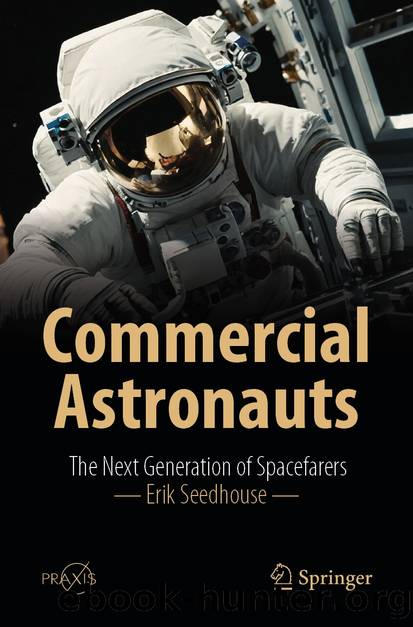Commercial Astronauts by Erik Seedhouse

Author:Erik Seedhouse
Language: eng
Format: epub
ISBN: 9783031556043
Publisher: Springer Nature Switzerland
Fig. 6.12The sliding filament theory. (Credit: David Richfield)
Of course, countermeasures for bone loss and muscle atrophy will comprise only part of the suite of exercise equipment that will be available to commercial astronauts because having strong bones and muscles will only get you so far; astronauts also need to maintain their exercise capacity. One metric for measuring aerobic capacity is maximal oxygen uptake which measures the amount of oxygen utilized by each kilogram of bodyweight per minute of exercise. As a commercial astronaut you will undoubtedly perform preflight, inflight and postflight measures of oxygen uptake and, like all physical fitness metrics, you will undergo an observed decline in your ability to utilize oxygen. Why? Well, first there is the issue of muscle atrophy. Imagine losing 20â25% of your respiratory muscle mass (your intercostal and intracostal muscles). This will make breathing more difficult. And then of course there is the loss of working (skeletal and cardiac) muscle mass. If your musclesâand heart!âare smaller, it stands to reason you will find it more difficult to work out. How much more difficult? Well, compared with pre-flight data, maximal oxygen uptake declines by between 15% and 25%.
So, by now we know astronautâs bodies suffer in microgravity. Without effective countermeasures, muscles atrophy, bones shed calcium, and astronauts get sick. But thatâs not all. Eyesight may also be affected. Weâve known about vision impairment in astronauts for some time, but the problem has only been put under the spotlight recently after some astronauts experienced severe eyesight deficiencies. Thanks to anecdotal reports by astronauts and a comparison of pre- and post-flight ocular measures, microgravity-induced visual acuity impairments have now been recognized as a significant risk (you can read more about this in Springerâs Microgravity and Vision Impairments in Astronauts written by yours truly). And this problem doesnât affect a minority of crewmembers: retrospective analysis of medical records revealed 29% of 300 Shuttle astronauts and 60% of space station astronauts have suffered some form of visual degradation. Thatâs a serious problem for an agency planning to send astronauts back to the Moon and eventually Mars. The problem has its own acronymâthis is NASA after allâand is referred to as the visual impairment/ intracranial pressure (VIIP) syndrome. Even though VIIP has only recently been identified, there has been significant research performed, so scientists are beginning to better understand the syndrome. The data shows that astronauts who suffer VIIP related symptoms experience varying degrees of visual performance decrements. Some suffer cotton-wool spot formation while others may present with edema of the optic disc. Other astronauts may suffer flattening of the posterior globe while some may present with distension of the optic nerve sheath. In short, there is a profusion of signs and symptoms but the reason for the vision impairment still has researchers flummoxed. One theory suggests the changes in ocular structure and impairment to the optic nerve is caused by the cephalothoracic fluid shift astronauts experience while on board the ISS. It is theorized some astronauts are more sensitive to fluid shift due to genetic and anatomical factors.
Download
This site does not store any files on its server. We only index and link to content provided by other sites. Please contact the content providers to delete copyright contents if any and email us, we'll remove relevant links or contents immediately.
| Aeronautics & Astronautics | Astronomy |
| Astrophysics & Space Science | Comets, Meteors & Asteroids |
| Cosmology | Mars |
| Solar System | Star-Gazing |
| Telescopes | UFOs |
Tools of Titans by Timothy Ferriss(8305)
Turbulence by E. J. Noyes(7980)
Secrets of Antigravity Propulsion: Tesla, UFOs, and Classified Aerospace Technology by Ph.D. Paul A. Laviolette(5335)
Astrophysics for People in a Hurry by Neil DeGrasse Tyson(5151)
Room 212 by Kate Stewart(5072)
Design of Trajectory Optimization Approach for Space Maneuver Vehicle Skip Entry Problems by Runqi Chai & Al Savvaris & Antonios Tsourdos & Senchun Chai(5038)
Pale Blue Dot by Carl Sagan(4957)
The David Icke Guide to the Global Conspiracy (and how to end it) by David Icke(4657)
A Journey Through Divination and Astronomy by Publishing Pottermore(4363)
Goodbye Paradise(3763)
Apollo 8 by Jeffrey Kluger(3668)
COSMOS by Carl Sagan(3589)
The Five People You Meet in Heaven by Mitch Albom(3520)
Losing the Nobel Prize by Brian Keating(3518)
How to Read Water: Clues and Patterns from Puddles to the Sea (Natural Navigation) by Tristan Gooley(3433)
Brief Answers to the Big Questions by Stephen Hawking(3393)
How to Read Nature by Tristan Gooley(3293)
The Order of Time by Carlo Rovelli(3162)
A Brief History of Time by Stephen Hawking(2992)
